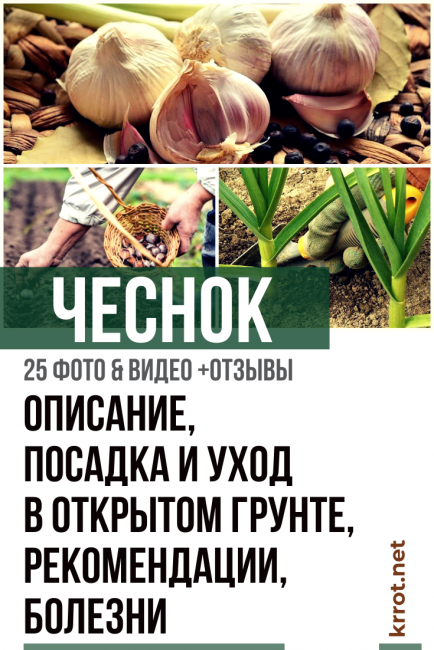
Garlic
Garlic is a perennial herb of the genus Onion from the Amaryllis family. Along with garlic, this genus includes all known types of garlic and onions. Despite the related similarity, these plants can be quite different from each other and have different growing conditions. Garlic is a fairly ancient culture; mankind has been growing it almost everywhere for almost 5 thousand years.
Due to its pungent taste and characteristic smell, the plant is mainly used as a seasoning in almost all cuisines of the world. The active substances contained in all parts of the plant, which have antibacterial and antiviral effects, have made garlic an integral component of many traditional medicine recipes. Being a plant with simple agricultural techniques, garlic does not impose special requirements on the level of the gardener: planting and caring for the plant is extremely simple.
Content:
 Read also: Hydrangea (90+ Photos) - description, outdoor care, reproduction, transplantation, diseases (Video) + Reviews
Read also: Hydrangea (90+ Photos) - description, outdoor care, reproduction, transplantation, diseases (Video) + Reviews
Botanical description of the plant
The garlic bulb has a complex structure and as it matures, it forms several dozen small onions called "cloves" or "teeth". Each clove is covered with a thin, but rather hard leathery shell. The teeth are convex on the outside and concave on the inside.
Most often, it is the cloves that are eaten. With their help, vegetative propagation of the plant is carried out. The color of the bulbs can be the most diverse - from white to dark purple.

garlic bulb
The plant has a fibrous root system of small size.
Garlic leaves are narrow and elongated: their width is about 1 cm, with a length of 30 to 100 cm. They have a pronounced central keel and a sharp point at the end. The leaves are arranged one inside the other, thus forming a complex and strong stem.

garlic stalk
Each plant has one flower stalk, its length is from 50 to 150 cm. At its end is an umbrella-shaped inflorescence, hidden before flowering by a membrane.
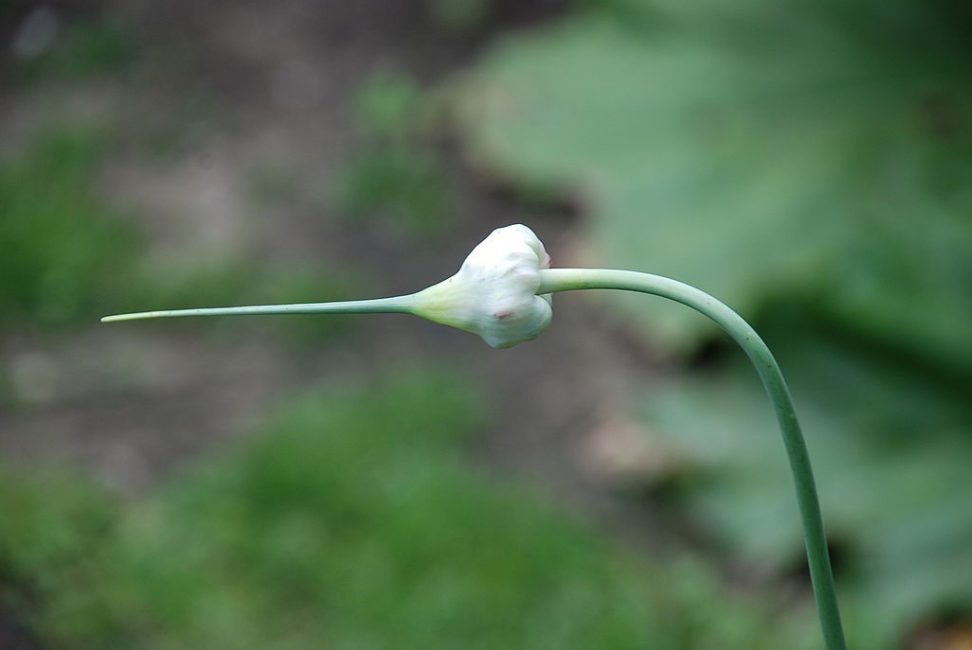
unopened garlic inflorescence
The inflorescence is arranged rather unusually. Inside the spherical umbrella are sterile flowers, as well as air bulbs, called "bulbs".
Despite the presence of flowers and even fruit boxes, garlic practically does not produce seeds. However, bulbs can also be used for vegetative propagation of garlic.

Inflorescence of garlic with flowers and air bulbs
There are two varieties of garlic: winter and spring, differing in planting dates and planting material.
Spring garlic is grown exclusively with bulb cloves., and winter - in all available ways:
- teeth
- sevkom (single-tooth bulb grown from a bulb)
- bulbsplanted as winter crops
Garlic bulbs are rich in polysaccharides, vitamin C, potassium, essential oils and allicin. It is thanks to allicin that garlic has a characteristic taste and smell.
An interesting fact is that allicin is not found in garlic in a "ready" form.; it appears due to a complex chemical reaction that occurs when the cells of the bulb are destroyed, for example, when it is cut.The presence of allicin is responsible for the antibacterial and antioxidant properties of garlic.
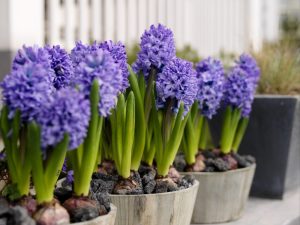 Read also: Hyacinth (80+ Photos) - Planting, care and reproduction at home - Elegant bouquet on the windowsill + Reviews
Read also: Hyacinth (80+ Photos) - Planting, care and reproduction at home - Elegant bouquet on the windowsill + Reviews planting garlic

Planting teeth
Planting site and soil properties
Since garlic has a reduced root system, which is mainly located in the upper layer of the soil, it needs a fairly fertile soil.. The site should have a neutral acid reaction (pH 6.1 to 7.0). Winter garlic grows well on sandy soils, spring - on loamy soils.

root system
The soil must be processed to a depth of two bayonets of a shovel (20-30 cm) and rid of impurities.
Garlic is not allowed to be grown in the lowlands, or, conversely, on the hills. In the first case, to avoid the accumulation of excess water from precipitation or melting snow. In the second, because of the winds, from which freezing of the plant can occur.
It is recommended to mulch the beds in autumn, however, in the spring the mulch layer must be removed to avoid overheating of the crop. It is also recommended to remove the mulch during significant warming in winter, when the snow melts abundantly. With the resumption of frost, it is returned back.
Ideal precursors of garlic are legumes, cruciferous and cucurbits. Growing garlic after any onion (including after itself) is possible only after 4 years.
It grows best in a separate bed, but when there is not enough space, or in order to scare off various pests, garlic can be grown in the neighborhood with a large number of plants.
Neighborhood with garlic is well experienced by nightshade (potato, tomatoes), pumpkin (cucumbers, zucchini), other onions. Well tolerated co-cultivation Strawberry, raspberries, gooseberry and currant. Of the ornamental crops, garlic goes well with roses, tulips and gladioli. legumes (beans, peas) and cruciferous (various types of cabbage) do not get along well with garlic, since the latter inhibits their growth.
In the case of planting winter garlic, the predecessor must be harvested no later than two months before the intended planting. Immediately after harvesting the predecessor crop, organic fertilizer should be applied to the soil. It may even be fresh. manure. In two months, it will overheat and it will make an ideal fertilizer.
Seed selection
Before planting, the bulbs must be divided into individual cloves.
To ensure good germination, cloves weighing at least 3 g should be planted.

Teeth selected for planting
Long-term reproduction only with the help of cloves leads to the fact that a large number of pathogens accumulate in the plant., which sooner or later leads to its degeneration.
Preparing the material for planting involves its thorough inspection and rejection.
The disinfection procedure consists in soaking all cloves for 12 hours in a 0.2% solution of potassium permanganate or 1% solution of copper sulphate.
Planting winter garlic
Winter garlic is planted in autumn, when the temperature of the topsoil drops to +12-15°C. This time comes around the end of September - beginning of October. The main thing is that with such a planting, the plant can form a good root system. This is the main factor that ensures a good harvest. Even if the plant sprouts in the fall, with good rooting, winter is not terrible for him.
Usually, the formation of the root system takes about 6 weeks.
Therefore, in the case of earlier winters in the area, the planting dates can be adjusted so that the garlic has time to take root.The bed itself should be pre-prepared about a week before the planned planting. It is dug to the required depth, loosened and cleaned.
If the fertilizer was not applied in advance, you can apply it now. But it should be something less active than fresh manure: it is recommended in this case to use compost or humus. The application rate is about 10 kg per 1 sq. m. It is also recommended to add a small amount of mineral fertilizers: up to 30 g of superphosphate and 20 g of some potassium salt. And 1-2 days before planting, 10 g of ammonium nitrate is added. All application rates are indicated for an area of 1 sq. m.
Garlic sits in rows, the distance between which is 20-30 cm. The plants themselves in a row are located at a distance of about 12 cm from each other. You can make individual holes, but it is better to make furrows for the entire length of the beds.

Planting winter garlic
The surface of the grooves should not be compacted, it is better after sprinkling the cloves with a layer of soil to slightly tamp the entire surface of the bed.
Planting should be moderately watered and mulched with a layer of peat 2-3 cm thick. A layer of brushwood is laid on top of the mulch to keep a layer of snow on the beds.
In the spring, brushwood and mulch should be removed to prevent seedlings from overheating.
Planting spring garlic
Preliminary tillage (digging up the site and fertilizing) is similar to autumn planting and is carried out in the middle of autumn last year.
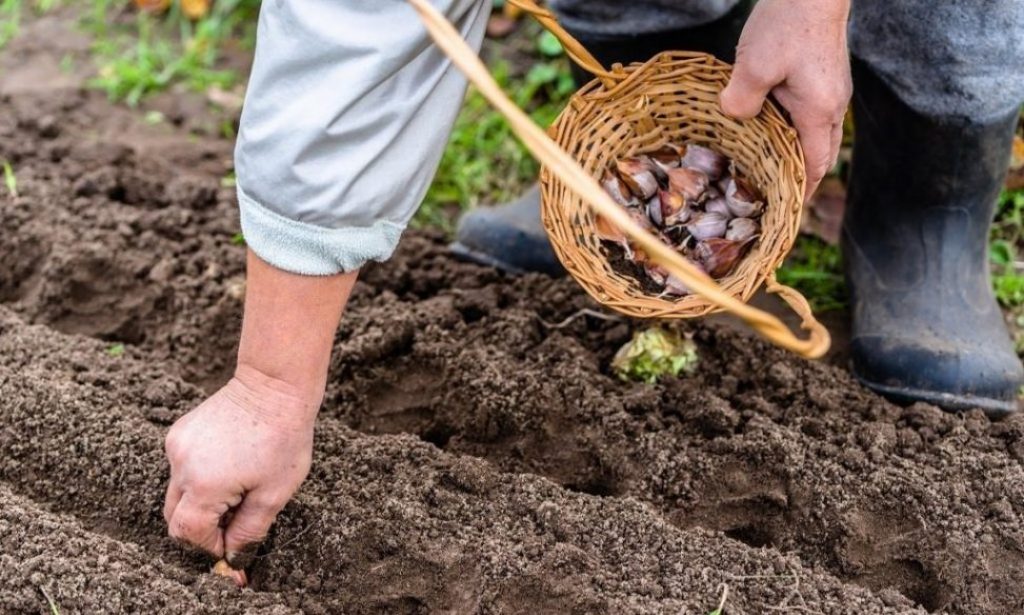
Planting spring garlic
Planting is carried out according to the same scheme (rows at a distance of 20-30 cm, the distance between plants is 10-12 cm).
Planting depth is slightly larger - up to 6 cm. This will protect the plants from possible frosts. Mulching is also desirable to be done with 2-3 cm of peat.
The average planting density of winter garlic is 50, spring - 55 cloves per 1 square. m.
Use of air bulbs
Air bulbs or bulbs can also be used when planting garlic in the winter. Their landing occurs approximately 2-3 weeks later than the landing of ordinary cloves, although simultaneous planting is also allowed.
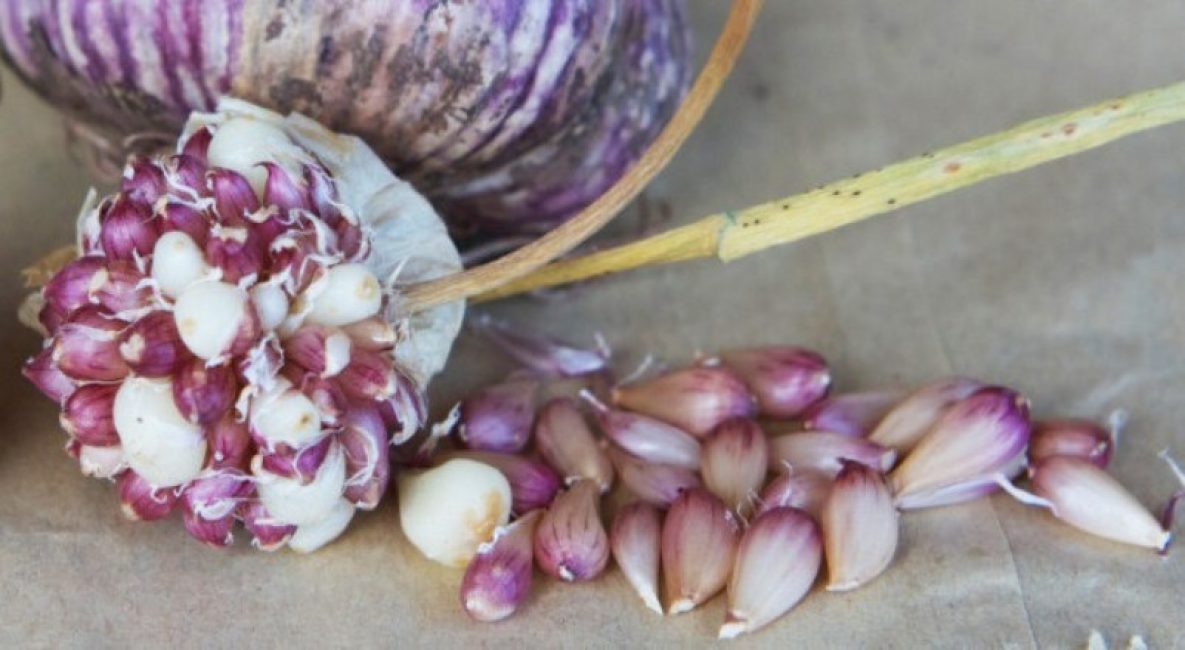
Aerial bulbs of garlic
To obtain a sevka, the peduncles of garlic do not break off, but they are allowed to fully ripen and harvested at the end of autumn. They are stored in a dry and warm place until the next year, and then sown. There are two possible dates for planting air bulbs: in May or in July.
Garlic planted in this way grows quite quickly. He should remove flower stalks as they appear.As soon as the stem begins to turn yellow (this usually happens in August), the bulbs are dug up, dried for 2-3 days and stored in a dry and dark place. In early October, such bulbs, called sets, are planted like ordinary winter garlic.
If air bulbs are planted in July, they do not have time to form sets, so they are used to obtain flowers and the next generation of air bulbs that will be sown next season.
 Read also: Azalea - description, care, reproduction and possible diseases (35 Photos & Videos) - We observe the cultivation technique
Read also: Azalea - description, care, reproduction and possible diseases (35 Photos & Videos) - We observe the cultivation technique
Care
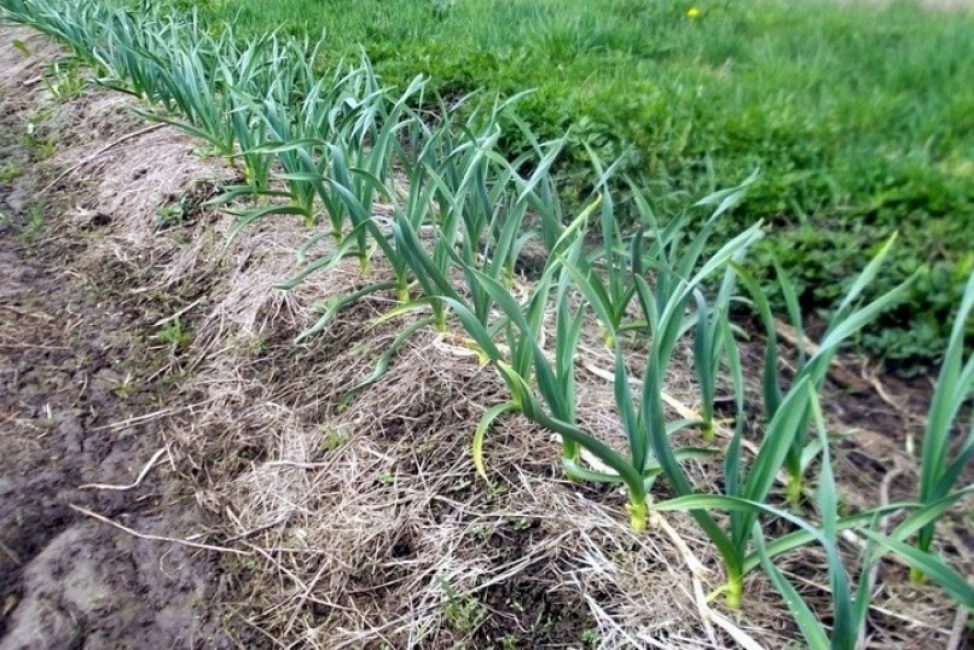
Mulched garlic.
Watering
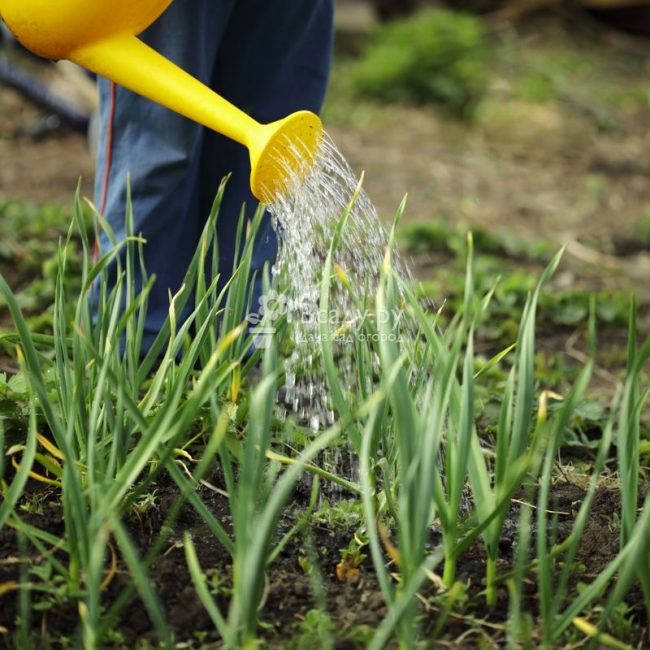
Watering
The first watering is done in late April - early May and is usually combined with the next top dressing. Stop watering a month before harvest. Harvest for winter garlic falls on the beginning of August, for spring garlic - from the third decade of August.
top dressing
In addition to fertilizing before planting, garlic needs to be fed 2-3 times during the season. It responds very well to top dressing, especially phosphate and potash fertilizers.
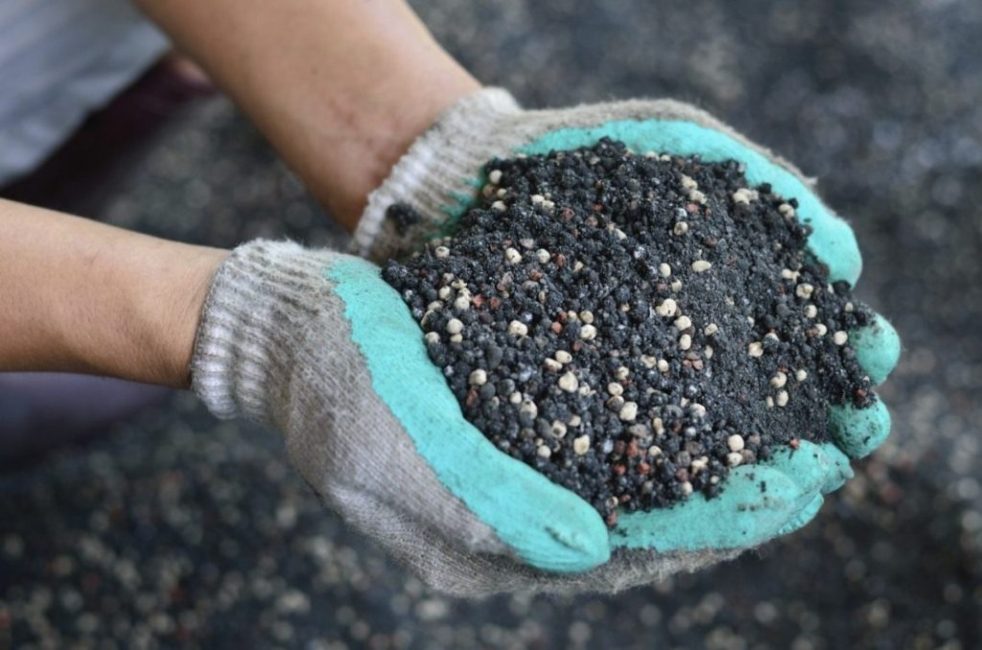
Autumn fertilization
The winter variety is fed for the first time, as soon as the snow melts. The composition of the feed is as follows:
- ammonium nitrate - 6 g
- superphosphate – 10 g
- potassium sulfate - 5 g
All norms are indicated for an area of \u200b\u200b1 sq. m.
The second and subsequent feeding is carried out at intervals of 1 month. In June, feeding stops.
Top dressing of spring garlic is carried out in a similar way, but with a shift in time due to the timing of planting. The first feeding occurs at the beginning of May, the second at the beginning of June, the third at the beginning of July.
Extra care
Garlic practically does not require any additional care, because due to the substances it contains and its size, it is able to perfectly compete with almost any weed.
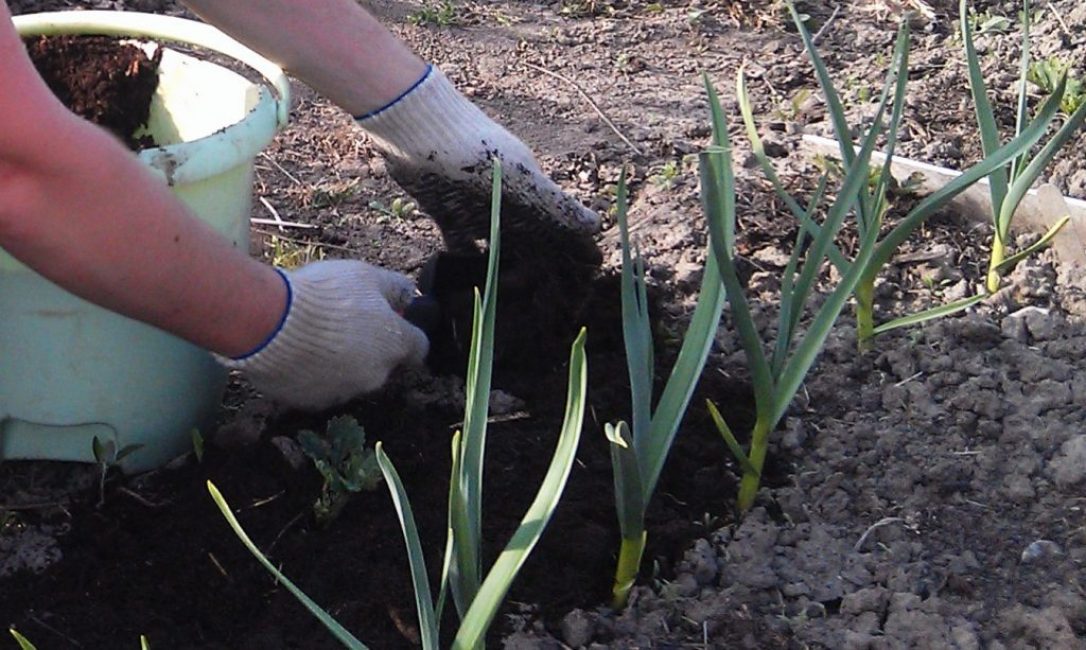
Introduction of humus
You can also loosen the soil after each watering, but there is no urgent need for this.
However, you should not get too carried away with the process and remove flower stalks from all plants. Usually, 1-2 plants are left on each row, which are allowed to bloom and form bulbs.. This is necessary to obtain part of the planting material from the flowers in order to avoid the degeneration of garlic.
Harvesting
Therefore, as soon as the first signs of ripening appear in the garlic, it must be removed.
These signs include:
- the appearance of a dense shell in the heads
- clear visualization of teeth
- color change of lower leaves from green to yellow
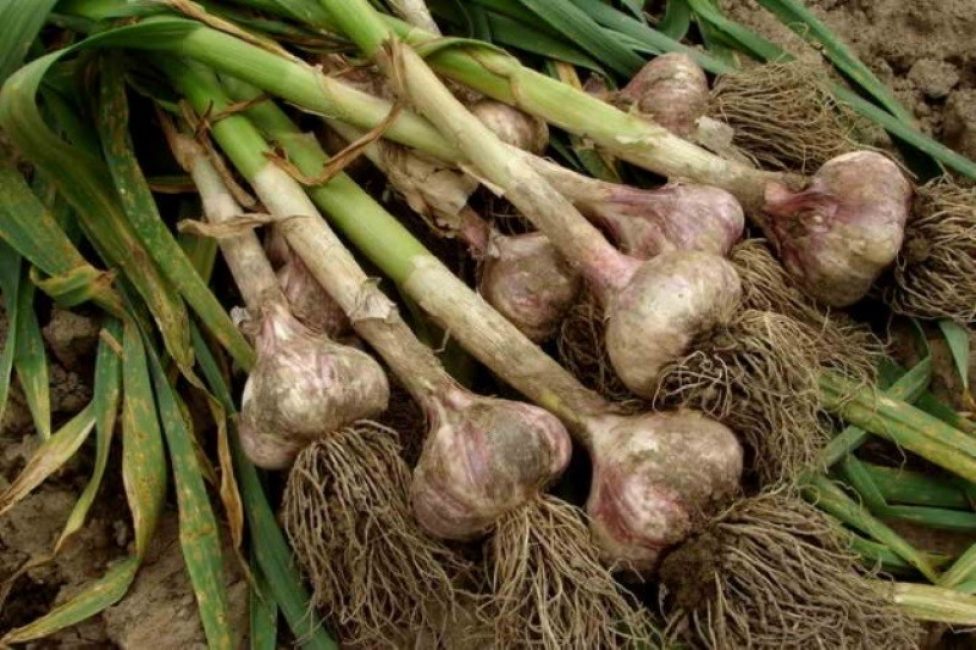
Harvesting
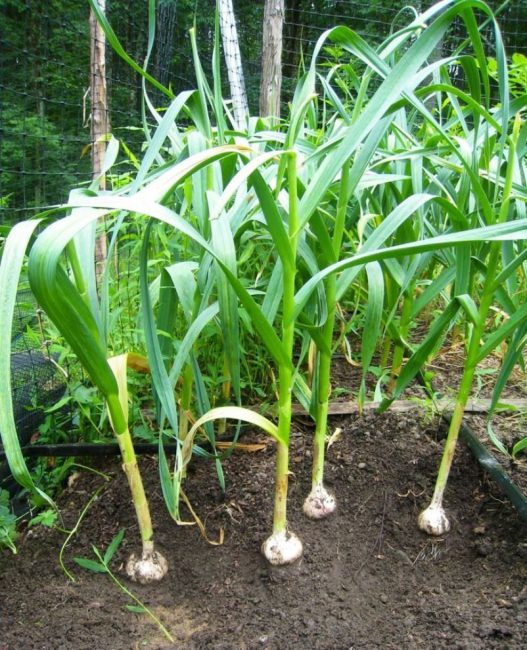
Bulb exposure before harvest
 Read also: How to grow tulips by March 8 at home? Planting, distillation, storage and other subtleties
Read also: How to grow tulips by March 8 at home? Planting, distillation, storage and other subtleties Plant diseases
Adult garlic has excellent disease resistance, however, in the first months of life, the plant is still vulnerable to a number of diseases. Mostly, these are fungal infections. The appearance of some of them, if timely measures are not taken, can destroy almost all young growth.
Often diseases affect the bulbs; Moreover, the defeat can occur both during the formation of the bulb, and during its storage. Consider these diseases in more detail:
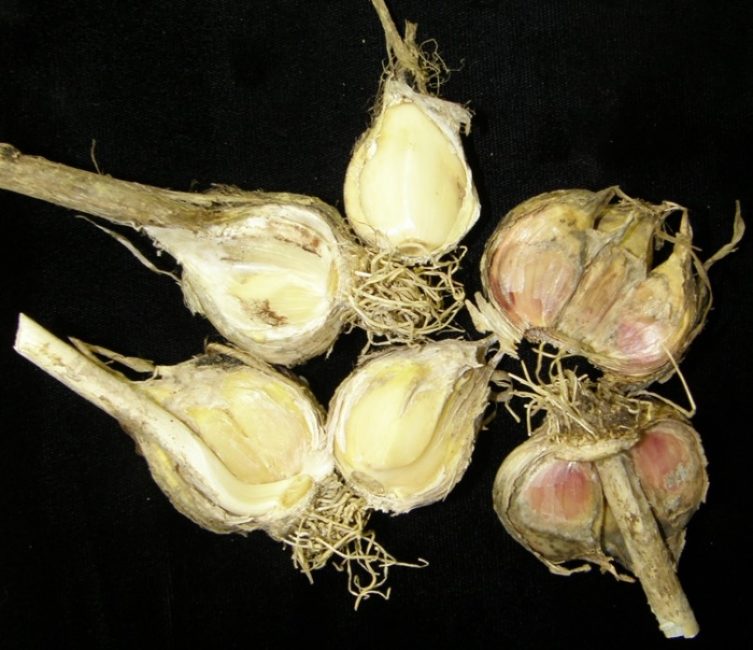
neck rot
It is one of the most common diseases. The necks of young bulbs, as well as the adjacent parts of the stem, are covered with gray spots, as if pressed inward. In the future, the infection spreads inside the bulb and can persist on the bulbs and plant debris for more than a year.
For a plant, the disease is not detrimental, but it can significantly spoil the crop.. To reduce the negative impact of the disease, after harvesting the garlic, dry the bulbs in a dry and well-ventilated room for two weeks at normal temperature, and then another 3 days indoors at a temperature of + 30 ° C. After the second drying, the bulbs should be treated with chalk.
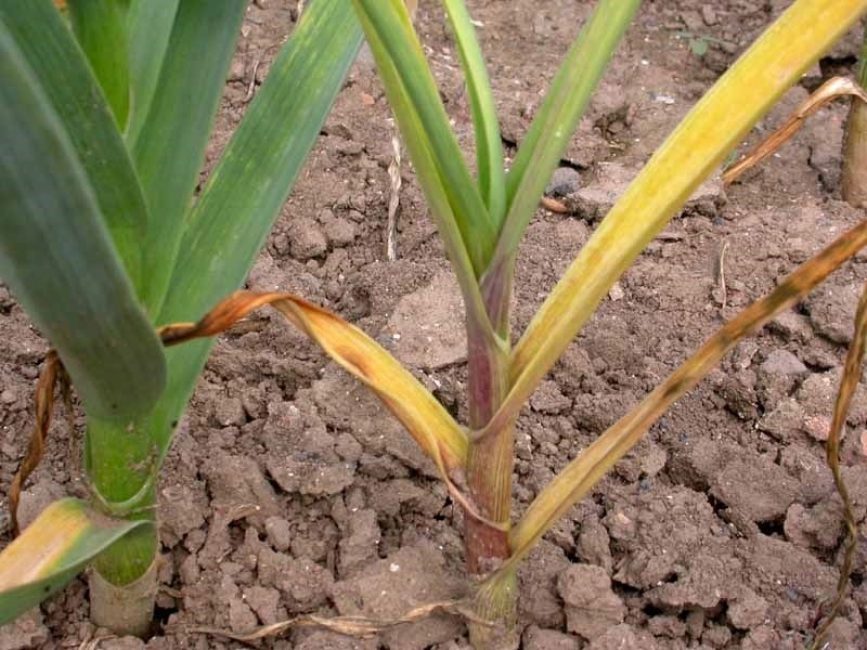
Stem of a plant affected by Fusarium
It affects the bottom of the bulbs and the root system. The bulbs become soft, and the roots acquire a pinkish tint. In the later stages, it causes damage to the stem and leaves and their death.
Plants affected by Fusarium should be dug up and destroyed, it is best to burn. As a preventive measure for the disease, a more careful selection of planting material and tillage of the soil before planting with a 1% solution of copper sulphate is recommended.
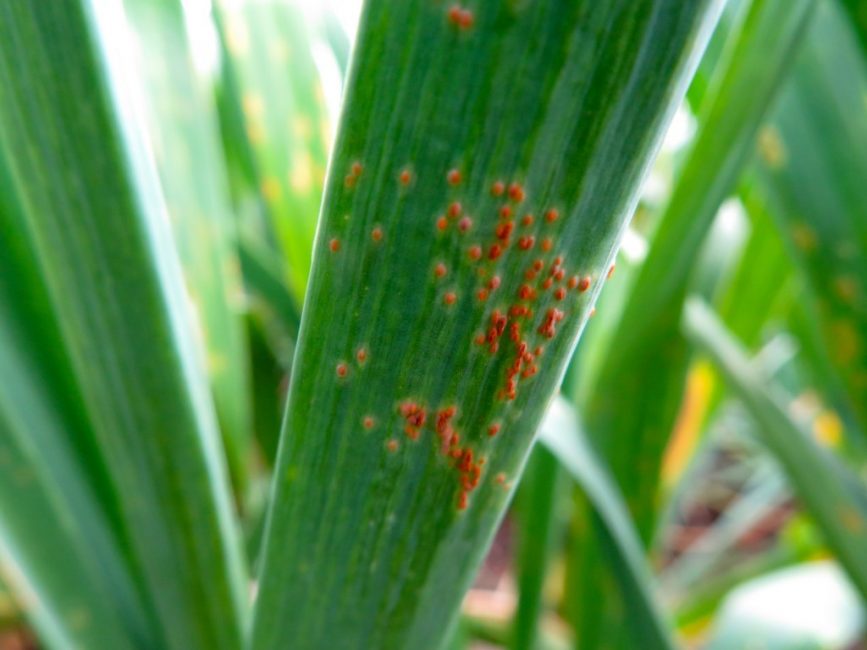
The manifestation of rust
It primarily affects the leaves. Light yellow or orange thickenings resembling pads form on them. After a few days, their color changes to black.
The fungus is able to exist on perennial types of garlic for several years. It is recommended that affected plants be treated with a 1% solution of copper chloride in water with the addition of 1 tbsp. spoons of liquid soap per 10 liters of spray mixture. Spraying is done once a week until the symptoms disappear.
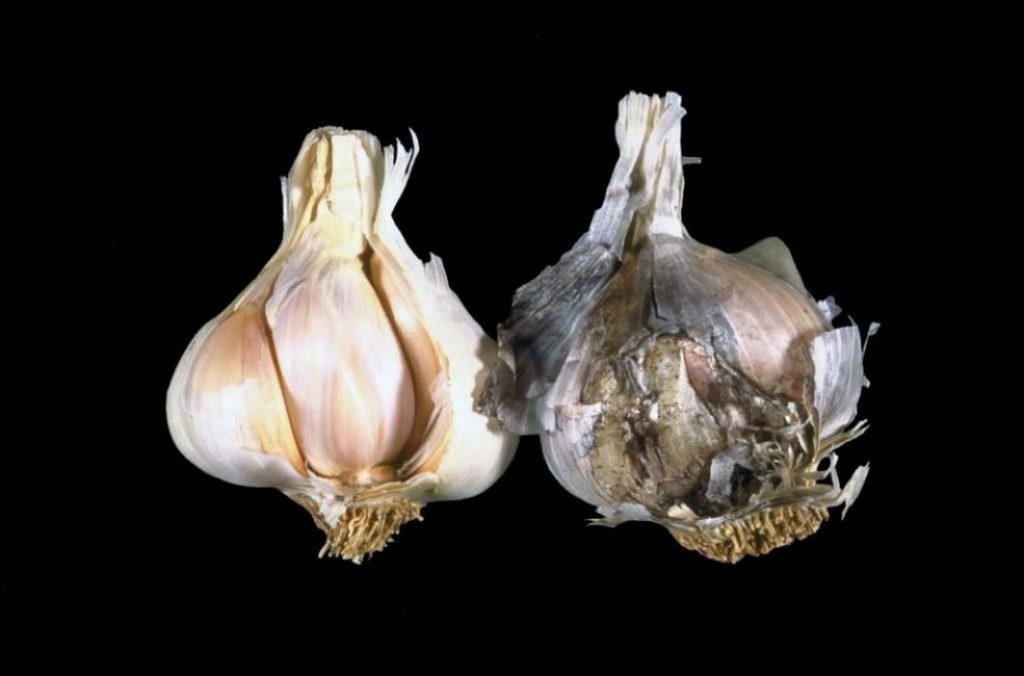
black mold
It has the appearance of characteristic black spots on the surface of the bulbs. Usually, it appears on the bulbs when storage conditions are violated, for example, elevated temperature and humidity. In affected bulbs, the outer cloves dry out.
Sevok can dry out completely. Affected bulbs should be removed and destroyed. For the rest, it is necessary to adjust the storage conditions and sprinkle them with chalk.
They have various external manifestations, most often consisting in the appearance of brown and brown ulcers on the bulbs and leaves. The growth of the plant is inhibited, the shape of the stem changes, the leaves dry out and die, and the yield decreases. Infected plants should be destroyed to prevent the spread of the disease.
If the disease manifested itself before harvesting, after harvesting, you should immediately start drying the bulbs in conditions of low humidity and a temperature of + 30 ° C. In case of extreme heat, drying in the sun in the open air is preferable. Preventive measures include careful selection of planting material and its processing before planting with copper sulphate or sodium chloride.
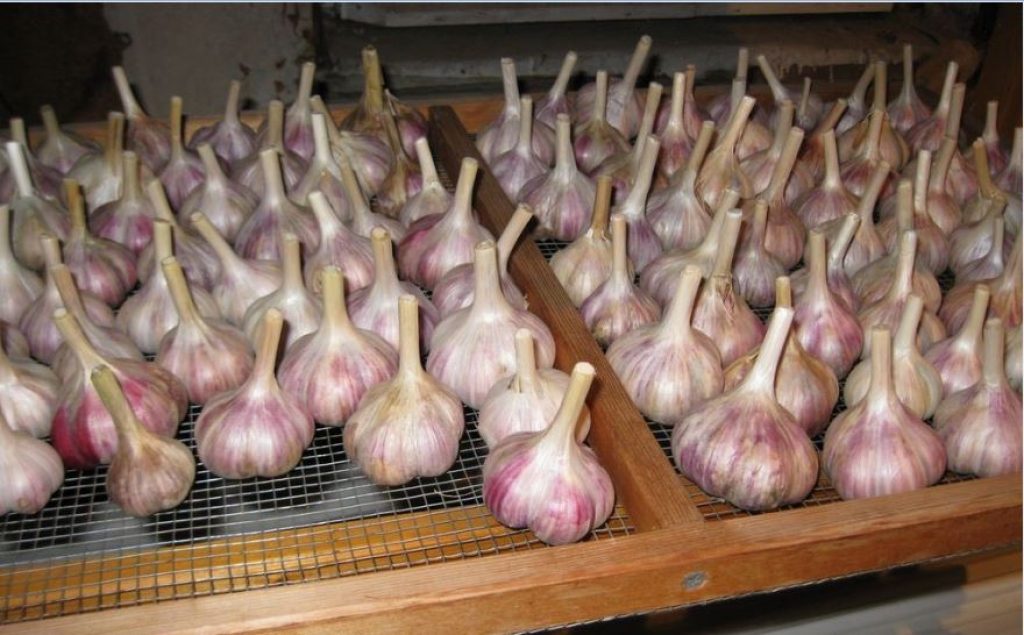
Drying garlic
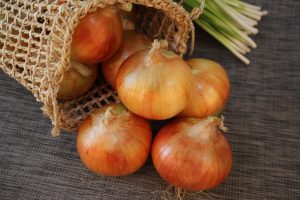 Read also: Onions - a description of 33 varieties with their photos and main characteristics, ripening dates and other useful information (Video) + Reviews
Read also: Onions - a description of 33 varieties with their photos and main characteristics, ripening dates and other useful information (Video) + Reviews
Conclusion
Garlic is one of the most common crops grown by mankind. The combination of many useful properties of the plant and very simple agricultural techniques provide garlic with a place in almost any garden.
The most difficult thing in growing this crop is the correct preparation of the seed., however, if you remember a very simple principle (2/3 seed from bulbs and 1/3 from flowers) and it will not be a problem.

healthy vegetables
VIDEO: Sowing and growing garlic. Time proven method
Garlic is an acute neighbor with a permanent residence permit: description, planting and care in the open field, recommendations, possible diseases (25 Photos & Videos) + Reviews



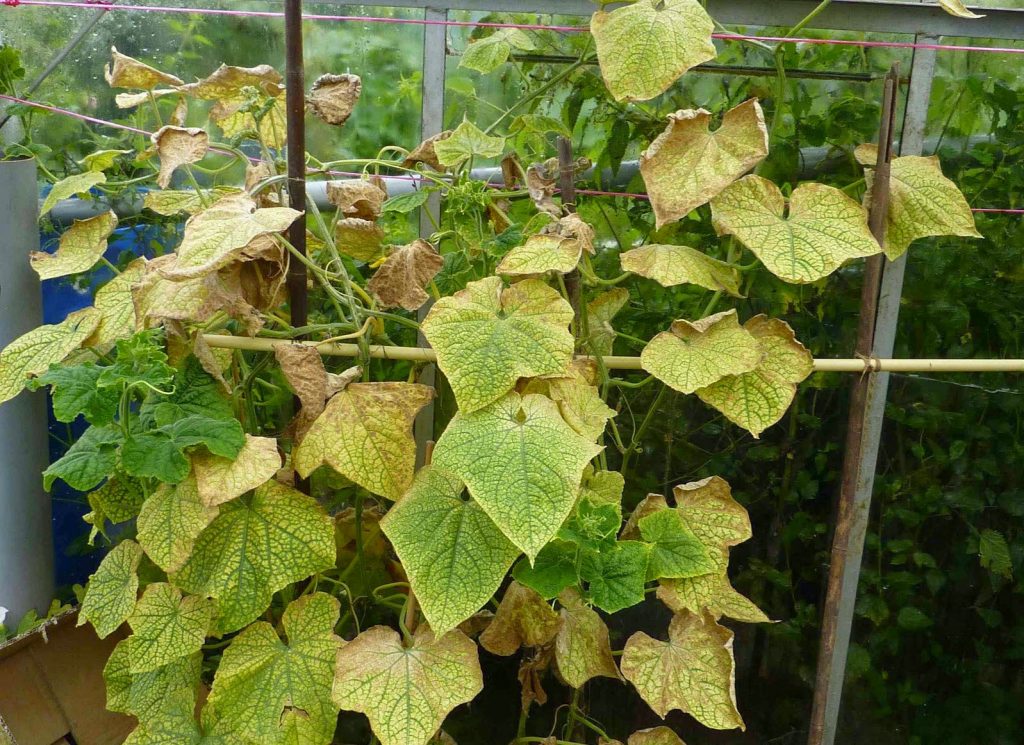



To achieve good harvests of garlic, soil mulching is necessary, as described in the article. But to prevent the mulch from overheating, dry straw should be used. It perfectly withstands the season without the process of decay. Mulching definitely doubles the yield of winter garlic. However, the onion fly can pretty much spoil the garlic. To avoid the spread of onion flies, it is necessary to sprinkle the beds where garlic grows abundantly with wood ash. Ash will not only destroy the fly, but also protect the garlic from other diseases.
very useful information, thanks